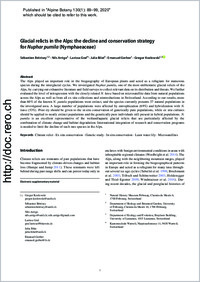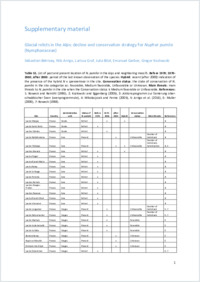Glacial relicts in the Alps: the decline and conservation strategy for Nuphar pumila (Nymphaeaceae)
- Bétrisey, Sébastien Natural History Museum Fribourg, Chemin du Musée 6, 1700 Fribourg, Switzerland - Department of Biology and Botanical Garden, University of Fribourg, Chemin du Musée 10, 1700 Fribourg, Switzerland
- Arrigo, Nils Department of Ecology and Evolution, Biophore Building, University of Lausanne, 1015 Lausanne, Switzerland
- Graf, Larissa Kantonsschule Wattwil, Näppisuelistrasse 11, 9630 Wattwil, Switzerland
- Bilat, Julia Department of Ecology and Evolution, Biophore Building, University of Lausanne, 1015 Lausanne, Switzerland
- Gerber, Emanuel Natural History Museum Fribourg, Chemin du Musée 6, 1700 Fribourg, Switzerland
- Kozlowski, Gregor Natural History Museum Fribourg, Chemin du Musée 6, 1700 Fribourg, Switzerland - Department of Biology and Botanical Garden, University of Fribourg, Chemin du Musée 10, 1700 Fribourg, Switzerland
-
01.04.2020
Published in:
- Alpine Botany. - 2020, vol. 130, no. 1, p. 89–99
English
The Alps played an important role in the biogeography of European plants and acted as a refugium for numerous species during the interglacial cycles. We investigated Nuphar pumila, one of the most emblematic glacial relicts of the Alps, by carrying out exhaustive literature and field surveys to collect relevant data on its distribution and threats. We further evaluated the level of introgression with the closely related N. lutea based on microsatellite data from natural populations across the Alps as well as from all ex situ collections and reintroductions in Switzerland. According to our results, more than 60% of the known N. pumila populations went extinct, and the species currently presents 37 natural populations in the investigated area. A large number of populations were affected by eutrophication (69%) and hybridization with N. lutea (53%). Priority should be given to the in situ conservation of genetically pure populations, while ex situ cultures should be applied to nearly extinct populations and the genetically pure individuals still present in hybrid populations. N. pumila is an excellent representative of the wetland/aquatic glacial relicts that are particularly affected by the combination of climate change and habitat degradation. International integration of research and conservation programs is needed to limit the decline of such rare species in the Alps.
- Faculty
- Faculté des sciences et de médecine
- Department
- Département de Biologie
- Language
-
- English
- Classification
- Biological sciences
- License
- License undefined
- Identifiers
-
- RERO DOC 328398
- DOI 10.1007/s00035-020-00232-9
- Persistent URL
- https://folia.unifr.ch/unifr/documents/308682
Other files
Statistics
Document views: 130
File downloads:
- koz_gra.pdf: 249
- koz_gra_sm.pdf: 125

